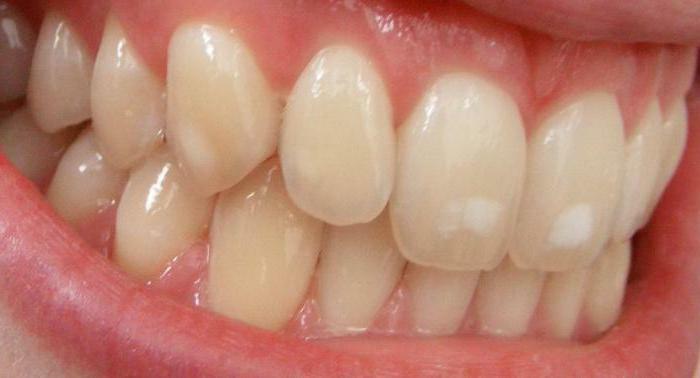Teeth fluorosis: causes, treatment, prevention
The main source of fluoride for the body is ordinary drinking water. How many useful micronutrients a person receives daily? Few know the answer to this question. However, getting a glut of fluoride is very easy. That is why the tooth enamel becomes spotty, and the dentist diagnoses "fluorosis".What is dangerous for this disease? How to cope with the defects that have appeared?
General Information
Fluorosis is a common disease that is the result of the intake of fluoride compounds in the body in large quantities. It develops gradually, has several forms. Symptoms of each of them vary. Some have only minor defects on the enamel, others suffer from complete tooth decay. That is why it is so important to diagnose a disease in time and start treating it. Doctors distinguish two of its types: professional and endemic. What are they different? Endemic fluorosis is diagnosed in certain regions where the quantitative content of fluorine in water and products is greatly overestimated. The risk of developing this disease increases if a person additionally takes drugs with this microelement. People who work in aluminum production are subject to occupational fluorosis. Along with air, a large amount of fluoride enters the body.
The main causes of the disease
Fluoride is necessary for the human body on a par with magnesium, calcium and potassium. Its deficiency leads to the development of caries, and excess - to fluorosis. Therefore, the supply of this trace element should be optimal.
To the greatest extent, the development of the disease affects young children, who have not yet strengthened tooth enamel. For this category of patients, the daily requirement of fluorine is 2-3 mg / l. They receive it together with food and water. For the development of fluorosis a rather small excess of this indicator. Adults with prolonged use of such water will not get sick, because for them the daily rate is 4 mg / l. However, exceeding the parameter by only two points may threaten the damage to the teeth. 
Forms of fluorosis
The disease has many forms, and each of them differs in its manifestations.
- Dashed. Characterized by the appearance of small strips on the surface of the enamel. They are distinctly distinguishable, but with a mild course of pathology, they are noticeable only by a detailed examination by a specialist.
- Spotted. The fluorosis of the teeth is manifested by whitish spots of various sizes. They can merge, forming a single defeat.
- Meloid-mottled. This form of the disease is characterized by the appearance of pigmented spots and points. The depth of the latter is 0.1-0.2 mm. The lesions are yellow, and the bottom of the spots is a brown tint.
- Erosive. The fluorosis of the teeth of this type is distinguished by the appearance of extensive foci of destruction, which are several times larger than the speckles in size. Otherwise, these lesions are called erosions.
- Destructive. This is the most serious form of the disease, in which the tooth is destroyed. On its surface, strong erosion is clearly discernible. Pathology is characterized by rapid erasure of enamel. Dental tissues gradually thin, become brittle. As a result, chips are formed.

How does fluorosis manifest?
The main symptom of the disease is a change in tooth enamel. At first it becomes covered with white or yellow spots, then becomes excessively sensitive. Teeth react violently to hot / cold food, temperature drops, easily destroyed. Spotted enamel can be caused by other pathologies. Therefore, to clarify the diagnosis should contact the dentist.
Fluorosis of the teeth is not accompanied by discomfort in the oral cavity. The disease gradually leads to thinning of the enamel. Only in this case are the following symptoms:
- hypersensitivity of the teeth;
- appearance of chips and cracks;
- occurrence of erosions, turning into caries.
The appearance of erosion threatens the gradual destruction of the tooth and its complete loss. As the pathological process develops, thinning of hard tissues, enamel and dentine, is noted. Severe form of the disease is accompanied by joint pain, weakness in the muscles and malaise. 
Development of the disease in children
Fluorosis most often develops in children living in areas with a high concentration of fluoride in water. At the same time, they are in this region since birth, when the final mineralization of the dental tissues takes place. By grouping calcium salts, fluorine removes them from the body. Moreover, it negatively affects the enameloblasts - the internal elements of the enamel. All this leads to its softening. This is how fluorosis develops in children. 
Principles of treatment for
Both children and adults need to start fighting with the disease by reducing the amount of fluoride entering the body. If it is not possible to replace drinking water, special filters should be used for cleaning. It is also recommended to abandon toothpastes and products( fish, spinach, tea) with a high content of fluoride. These actions will not help to eliminate the already formed spots on the enamel, but will stop the progression of the disease called fluorosis.
Treatment of ailment depends on the severity of the pathological process. With fluorosis at the initial stage only the shade of enamel changes. In this case, patients are recommended teeth whitening and remineralizing therapy( saturation of tissues with fluoride and calcium).Getting into hard tooth tissues, these compounds strengthen and restore their structure. The procedure is carried out using phonophoresis or appliques. Adult patients are additionally prescribed medications for suspected fluorosis. Treatment with "Remodent" shows excellent results. This remedy is obtained from the bones of animals. When applied to the enamel, useful substances fall on its upper layer and restore the structure.
The disease of moderate and severe severity is always accompanied by irreversible disorders. If the integrity of the enamel is damaged, whitening is ineffective. In such cases, aesthetic restoration of teeth is used for treatment. Usually, ceramic veneers or crowns are used. 
Methods of prevention
To prevent fluorosis of the teeth, its prevention must be dealt with from an early age. The child is recommended to be transferred to artificial feeding as late as possible. In the future, he needs to ensure a balanced diet, if possible, replace water with milk. It is useful for the summer holidays to send the child to the health camps or to the grandmother in the village, so that for a time he could change the water source. Adult for the prevention of fluorosis toothpaste and rinsers for the oral cavity should be chosen without fluoride.
